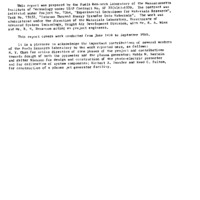-
Title
-
Optical Methods Of Measuring Plasma Jet Temperatures
-
Date
-
1961
-
Index Abstract
-
Contrails and DTIC condensed
-
Photo Quality
-
Incomplete
-
Report Number
-
WADD TR 60-676
-
Creator
-
Hottel, H. C.
-
Jensen, W. P.
-
Williams, G. C.
-
Corporate Author
-
Massachusetts Institute of Technology
-
Laboratory
-
Materials Laboratory
-
Extent
-
77
-
Identifier
-
AD0266723
-
AD0266723
-
Access Rights
-
OTS
-
Distribution Classification
-
1
-
Contract
-
AF 33(616)-6570
-
DoD Project
-
7364
-
DoD Task
-
73652
-
DTIC Record Exists
-
Yes
-
Distribution Change Authority Correspondence
-
None
-
Report Availability
-
Full text available
-
Date Issued
-
1961-06
-
Abstract
-
A literature study was made of methods for measuring temperatures of hot gases and plasmas, with particular emphasis on evaluation of non-spectroscopic techniques. For application to measurements on air stabilized plasma jets at temperatures to 8000°K and in the pressure range from 0.01 to 10 atmospheres, an optical technique was chosen, modified for fast response by use of a multiplier phototube as the receiver. The technique involves display on a cathode ray oscilloscope of signals alternately representing first a single path and then a double path (by means of a mirror) of the image of a portion of the plasma jet, the alternation being at 13 cycles per second. The double path image is attenuated by means of a neutral filter and the chopped signal is compares with that of a calibrated pyrometer filament, the image of which is made to appear upon the oscilloscope screen, again at a frequency of 13 cps, by means of a passage through a glass refraction block. Th measurement of integral intensity is made nearly monochromatic by the use of very narrow band interference filters, e.g., a sodium D line filter peaked at 5892 Å, with a half width of 7.5 Å. With an additive producing constant absorption over the range of the filter, the effect on intensity of doubling the path is used to infer the intensity of black radiation - and therefrom the temperature - by conventional use of Beer's law. With an additive producing line emission within the wavelength range of the filter, the interpretation of path doubling becomes more complicated; and the normalized shape of the line must be used in the interpretation of the pyrometer readings. Extension of the range of possible temperature measurement to as high as 10,000°K is possible by interposition between the target and the pyrometer filament of neutral density glass filters, each having a transmissivity of about 4.5%.
-
Subject
-
Bibliographies
-
Gases
-
High Temperature
-
Optical Analysis
-
Plasma Jets
-
Pyrometers
-
Attenuation
-
Gas Ionization
-
Instrumentation
-
Intensity
-
Laboratory Equipment
-
Measurement
-
Microwaves
-
Optical Filters
-
Oscilloscopes
-
Photoelectric Effect
-
Photomultiplier Tubes
-
Sound Transmission
-
Spectrography
-
Temperature
-
Test Equipment
-
Test Methods
-
Thermocouples
-
Thermodynamics
-
Thermometers
-
Publisher
-
Wright-Patterson Air Force Base, OH : Aeronautical Systems Division, Air Force Systems Command, United States Air Force
-
Distribution Conflict
-
No
-
Provenance
-
IIT
-
Type
-
report
-
Format
-
1 online resource
 WADDTR60-676.pdf
WADDTR60-676.pdf